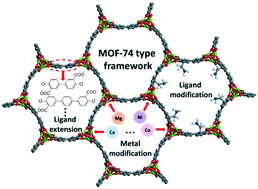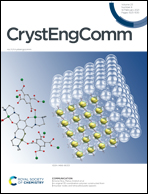MOF-74-type frameworks: tunable pore environment and functionality through metal and ligand modification
Abstract
MOF-74-type frameworks are considered one of the most promising metal–organic frameworks owing to their remarkable structural features and properties such as a high density of open metal sites, hexagonal channels along the c-axis, and high porosity. Diverse strategies have been adopted to prepare bimetallic MOF-74 frameworks, in the pursuit of synergistic effects and enhanced properties originating from different metal sites that serve as Lewis acidic sites. Moreover, extended versions of the MOF-74-type structure have been demonstrated in terms of ligand extension, featuring enhanced pore size and surface area. The extended variants of MOF-74 are beneficial for the incorporation of additional functional groups due to the relatively larger pore size. Pre- or post-synthetic modification approaches have been applied to introduce functionalities into the framework, resulting in desirable and superior properties such as chemical stability, binding affinity, and catalytic activity. This review addresses the significant progress made in the development of MOF-74-type frameworks with respect to synthetic strategies and modification approaches.

- This article is part of the themed collection: Coordination Networks


 Please wait while we load your content...
Please wait while we load your content...